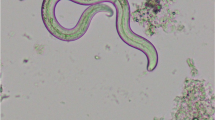Abstract
In quantitatively infected Meriones unguiculatus autopsied during prepatency, the embryonic development of fertilized eggs in the uteri of female Dipetalonema viteae commenced 29–32 days p.i., and approximately 20 days later the first microfilariae were released. In host animals examined at the onset of patency 45–59 days p.i. the average adult recovery rate was 31%. The worms were localized in the subcutaneous tissue (65.3%), fasciae of muscles (26.9%) and body cavities (7.8%). Female worms from the peritoneal and pleural cavities were significantly longer (44.3±10.4 mm) than those from the other habitats (33.7±5.5 mm). Female worms 14–20 weeks p.i. contained a total of 172700±62400 intrauterine stages, 21% of them pathologically altered. Based on these parameters, the expected in vivo fecundity of a female worm was calculated as about 7000 microfilariae per day.
Similar content being viewed by others
References
Barthold E, Wenk P (1986) Quantitative relations in the extrinsic development of Dipetalonema viteae (Nematoda, Filarioidea) in the vector tick Ornithodorus moubata. Z Angew Zool 73:49–62
Bayer M (1983) Versuche zu einer gekreuzten ImmunitÄt zwischen Dipetalonema viteae und Litomosoides carinii (Nematoda, Filarioidea) nach Injektion von Mikrofilarien in Meriones unguiculatus. Thesis Diploma, Biology, University of Tübingen, FRG, p 44
Johnson MH, Orihel TC, Beaver PC (1974) Dipetalonema viteae in the experimentally infected jird, Meriones unguiculatus: I. Insemination, development from egg to microfilariae, reinsemination, and longevity of mated and unmated worms. J Parasitol 60:302–309
Mössinger J, Wenk P (1986) Fecundity of Litomosoides carinii (Nematoda, Filarioidea) in vivo and in vitro. Z Parasitenkd 72:121–131
Mössinger J, Wenk P, Schulz-Key H (1987) In vitro maintenance of adult Dipetalonema viteae and Litomosoides carinii (Nematoda, Filarioidea): fecundity and survival in cell-free culture systems. International Symposion on in vitro cultivation of parasites and alternatives to animal experimentation in parasitology, Zürich April 1987, abstracts. Zentralbl Bakteriol Mikrobiol Hyg [A] (in press)
Nogami S, Tanaka H, Matsuda H (1983) Migration of adult worms of Dipetalonema viteae subcutaneously transplanted into the jird. Jpn J Parasitol 32:137–142
Wegerhof PH, Wenk P (1979) Studies on acquired resistance of the cotton rat against microfilariae of Litomosoides carinii: I. Effects of single and repeated injections of microfilariae. Z Parasitenkd 60:55–64
Weinstein PP, Highman B (1974) Infection of the jird, Meriones unguiculatus, with the filarial worm, Dipetalonema viteae: central nervous system invasion and pathology. J Parasitol 60:138–148
Weiss N (1970) Parasitologische und immunologische Untersuchungen über die durch Dipetalonema viteae erzeugte Nagetierfilariose. Acta Trop Separatum 27:217–259
Wenk P (1986) The function of non circulating microfilariae: Litomosoides carinii (Nematoda: Filarioidea). DTW 93:414–418
Worms MJ, Terry RJ, Terry A (1961) Dipetalonema witei, filarial parasite of the jird, Meriones libycus: I. Maintenance in the laboratory. J Parasitol 47:963–970
Author information
Authors and Affiliations
Additional information
Dedicated to Prof. Dr. P. Wenk
Rights and permissions
About this article
Cite this article
Mössinger, J., Barthold, E. Fecundity and localization of Dipetalonema viteae (Nematoda, Filarioidea) in the jird Meriones unguiculatus . Parasitol Res 74, 84–87 (1987). https://doi.org/10.1007/BF00534937
Accepted:
Issue Date:
DOI: https://doi.org/10.1007/BF00534937




